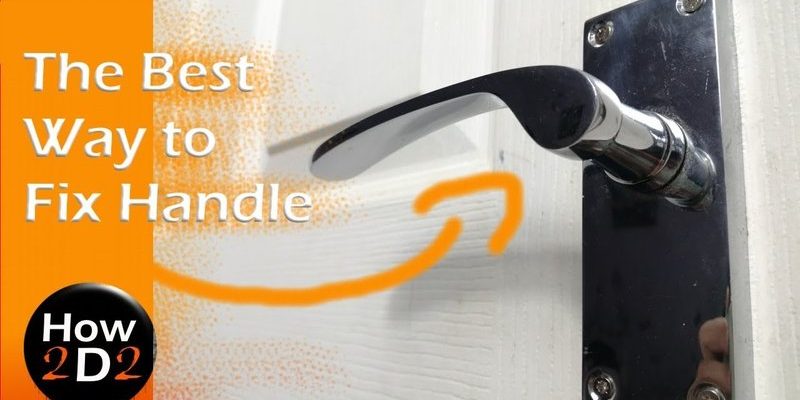
When your door knob spindle receiver is stripped, it may feel like the door is just a collection of parts rather than functioning as it should. It might give you the same vibe as having a favorite chair with a wobbly leg—annoying and unstable, but fixable. In this guide, we’ll walk through how to identify the problem, gather the right tools, and successfully repair or replace that pesky spindle receiver, making your door as good as new.
Identifying a Stripped Spindle Receiver
Before diving into repairs, you’ll want to confirm that the issue lies with the spindle receiver. Here’s how to check. First, gently pull the knob away from the door, turning it back and forth. If it spins easily without catching, you might have a problem. Stripped spindles are often caused by wear and tear from repeated use, much like how an old car’s engine might struggle to start after years of service.
Next, remove the knob from the door. This usually involves unscrewing a set screw or using a flathead screwdriver to pry off the cover plate. Once the knob is off, look for the spindle, which is a metal rod that connects the doorknob to the latch mechanism. If the spindle moves freely without resistance, your spindle receiver is likely stripped. At this point, you’re ready to roll up your sleeves and get to work!
Gathering the Right Tools
Having the correct tools is crucial for a successful repair. You don’t want to start a project only to realize you’re missing an essential item. Here’s a quick list of what you’ll need:
- Flathead screwdriver
- Phillips screwdriver
- Pliers
- Replacement spindle or setscrew (if needed)
- Wood glue or epoxy (optional, depending on your repair method)
Most of these tools are probably already sitting in your toolbox. If not, they’re readily available at any hardware store. When selecting a replacement spindle, make sure to find one that matches the style and size of your current setup. You don’t want to run into issues later down the line because of a mismatched part.
Removing the Damaged Spindle Receiver
To repair the stripped receiver, you’ll first need to remove the damaged part. Here’s how to do it step by step:
1. Take off the doorknob: Using the appropriate screwdriver, remove the knob and any visible screws.
2. Unscrew the receiver: Look for screws holding the spindle receiver in place. Carefully unscrew and remove them.
3. Inspect and clean: Once removed, take a good look at the area. Is there debris or dirt? Clean it with a cloth to ensure a smooth installation of the new receiver.
Removing the old receiver can feel like untangling a knot; it requires patience but is entirely doable. Once you’ve completed this, you’ll be ready for the next step.
Installing a New Spindle Receiver
Now that you’ve removed the damaged receiver, it’s time to install the new one. Here’s how to do it:
1. Position the new receiver: Align it with the knob and the latch area. Make sure it’s snug against the door.
2. Screw it in place: Reattach the screws you removed earlier. Make sure they’re tight but not overly so—over-tightening can lead to more damage.
3. Reattach the doorknob: Slide the doorknob back onto the spindle and secure it according to your previous setup.
If you’ve ever put together furniture from a box, you’ll likely find this step straightforward, as it’s a similar process. Double-check that everything is aligned correctly before you finish.
Testing the Door Knob
Once you’ve reassembled everything, it’s time to test the door knob. This step is like the moment of truth in any DIY project. Here’s what to do:
1. Check the knob’s movement: Turn the knob several times to ensure it moves freely without catching or wobbling.
2. Test the latch: Close the door and check if the latch catches securely. If it doesn’t, you might need to adjust the alignment.
3. Try the door from both sides: Don’t forget to check the knob’s operation from both the inside and outside of the door.
If everything feels right, congratulations! You’ve just tackled a common household repair that many overlook. Enjoy the smooth functioning of your newly fixed door knob.
When to Call a Professional
Sometimes, despite our best efforts, a repair doesn’t go as planned. If you find that the new spindle receiver doesn’t fit or the door knob continues to malfunction, it might be time to call in a professional. Here are a few signs it might be wise to seek help:
– You’ve attempted the repair multiple times without success.
– The door frame or latch mechanism appears damaged.
– You’re unsure about the alignment and installation process.
Having a skilled handyman or locksmith step in can save you time and frustration. They can assess the situation, identify underlying issues, and ensure everything is repaired correctly.
Preventing Future Stripped Spindle Receivers
Now that your door knob is functioning properly, it’s a good idea to take some simple steps to prevent future problems. Here are a few tips:
– Regular maintenance: Check your doorknobs periodically for any signs of wear and tear.
– Lubricate moving parts: A little bit of lubricant can go a long way in keeping your knobs and latches operating smoothly.
– Be gentle: Remind family members to avoid slamming doors or using excessive force on knobs.
Think of these steps as an investment in the longevity of your hardware. Just like maintaining a car, a little care goes a long way in preventing bigger repairs down the road.
In conclusion, repairing a stripped interior door knob spindle receiver is a manageable DIY task that can save you from unnecessary expenses and hassle. With the right tools and a bit of patience, you can restore function to your door knob and even gain some handy skills along the way. Remember, every repair is an opportunity to learn something new about your home!
